About 10 contributing artists
What If takes a look at the way contemporary art uses architecture and design. Over the past decade, these two have appeared with increasing frequency as areas for artists to work with. What If has gathered 30 young international artists and artist groups whose work is related to these two associated disciplines. In a variety of ways, their works open up a dialogue with the experience of, and the expectations on, our designed and constructed age. What If could be described as a forum for the exploration of these matters, a forum where conversations on this topic will last for the entire period of exhibition, for instance in the form of listen-ins.
Michael Elmgreen & Ingar Dragset
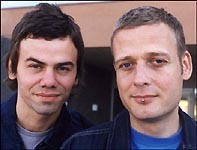 Michael Elmgreen, b 1961 in Denmark, & Ingar Dragset, b 1969 in Norway, work and live in Berlin.
Michael Elmgreen, b 1961 in Denmark, & Ingar Dragset, b 1969 in Norway, work and live in Berlin.
Michael Elmgreen’s and Ingar Dragset’s contribution to What If consists of a sort of barter between themselves as artists and Moderna Museet as institution. They have placed one of the museum’s characteristic benches inside their own apartment in Berlin, providing the museum with an entrance sign in return. That way, Elmgreen and Dragset reverse the roles in the relations between artist and museum, on the one hand, and the private and the public, on the other. At the same time, however, they’ve seen to it that both parties got what they had been missing – the artists could finally furnish their home, and the museum received, at long last, a sign for the entrance. The exchange is a part of their continuing series of projects, Powerless Structures, which, among other things, challenge the conventions in architectural and social structures, while at the same time offering other options.
Apolonija Sustersic
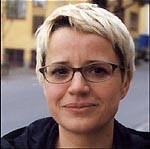 Born in 1965 in Ljubljana, lives and works in Ljubljana and Amsterdam.
Born in 1965 in Ljubljana, lives and works in Ljubljana and Amsterdam.
Suggestion for the Day is a kind of picnic package that includes a rent-a-bike/rental service of four city bikes free of charge, a postcard depicting different parts of Stockholm and a map of the city where specific places are marked and equipped with commentaries. The places that has been selected are not common tourist sites but provide in one way or another interesting topics for debate on the planning and meaning of the city room. In that way the work connects in its own way to the present debate about the city planning of Stockholm. Apolonija Sustersic’s work involves almost always human activity – the audience’s active participation is consequently needed to make the work function. In connection with museums she often places another unexpected and practically useable service at the audience’s disposal. This time it involves the possibility to travel through and discover the city of Stockholm from a different perspective.
Martin Boyce
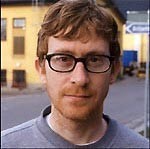 Born in 1967 in Glasgow where he works and lives.
Born in 1967 in Glasgow where he works and lives.
Martin Boyce is interested in how the meaning of the modernist idiom has changed along the way from the ideological climate of the 1950’s to the societal structure of today. It is the story of the mass-produced, well-designed and cheap piece of furniture that is transformed into an exclusive collector’s item. Now I’ve Got Real Worry (1 and 2) are handmade sculptural versions of the storage units that once was created by the legendary designer team Charles and Ray Eames in 1950’s Los Angeles. Martin Boyce has also furnished the sculptures with Private Property-signs that are supposed to protect property in a society that is all but equal. When Now Is Night is a wallpaper that unites a typical 50’s style pattern with the net-like structure in the vignette for Alfred Hitchcock’s film North by Northwest. The work functions as a kind of visual soundtrack to the large city at night and refers to the city environment as a gigantic Metropolis.
Gunilla Klingberg
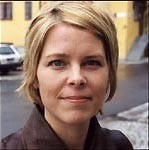 Born in 1966 in Stockholm where she lives and works.
Born in 1966 in Stockholm where she lives and works.
Gunilla Klingberg has for several years worked with different low-price shops’ logotypes and the message they convey. She explores among other things how the graphic expression makes us customers identify with a specific chain of stores and the culture it represents. The work Sparspace uses the low-price chain of shops Sparlivs logotype. It has been multiplied in a pattern that seems to suck both itself and the viewer into a kind of common centre of temptation and threat. In this way Sparspace drives the permanent exposure and the suggestion of the Sparlivs logotype to an extreme. In a world where we are constantly exposed to the commercial message the work can also be viewed as a sort of counter-movement: the logotypes that are forced on us are chewed and spat out in a different version.
Tobias Rehberger
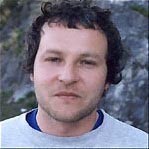 Born 1966 in Esslingen, lives and works in Frankfurt.
Born 1966 in Esslingen, lives and works in Frankfurt.
Tobias Rehberger had a small, cabin-like house constructed inside Moderna Museet. Once the exhibition What If has ended, the hut will be dismantled in order to be transported and reassembled in northern Thailand. There, fellow artist – and landowner – Rikrit Tiravanija will establish a zone harbouring a rice-cultivation development project, at the same time serving as a meeting place for friends and acquaintances. The walls of the third floor of the hut consist of a number of transparent screens of different colours, which can be moved around at will. The hut is actually four stories high, but the pole construction at the bottom level will have to wait until the house has moved out of the museum. The design of the work takes its start in the characteristics of a German dish, a Japanese interest in the relation between light and darkness, and from the fact that the hut is built and shown in one part of the world before it’s used, for practical purposes, in another.
Sarah Morris
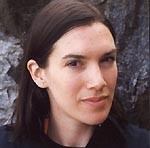 Sarah Morris är född 1967, bor och arbetar i New York och London.
Sarah Morris är född 1967, bor och arbetar i New York och London.
In Sarah Morris’ film AM/PM the camera moves in an urban landscape that has erased the line between day and night – more exactly the gamble- and entertainment city of Las Vegas. Here capitalist interests have created an artificial world where people and vehicles move in an eternal flow of time. The theme of the film is the mental experience of the 24hour city as a tempting and restless row of different impressions, without any connection between them. It is also this experience of Las Vegas that constitutes the form of Sarah Morris’ methodology and imagery. The camera brings the viewer along on a seemingly planless trip through the city – to fast-beating music – and draws attention to what happens to come in its way. The possible or impossible narrative is left to the viewers to read for themselves in the version of a manipulated reality that AM/PM portrays in form and content.
Nathan Coley
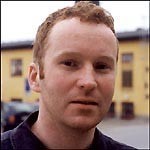 Nathan Coley är född 1967 i Glasgow, bor och arbetar i Dundee.
Nathan Coley är född 1967 i Glasgow, bor och arbetar i Dundee.
Urban Sanctuary is a public work of art that has taken the form of a publication. The work is based on the public commission that Stills Gallery in Edinburgh assigned Nathan Coley a few years ago. He decided to build a secular sanctuary in the city. To research how he best could proceed he interviewed a number of people with knowledge in the field, among others a representative of the Church, a chief of police and a Feng-Shui consultant. This lead to the result that Nathan Coley did not want the work of art to be built but instead let it be materialised in bookform and available at the city library. The book contains all the interviews he did within the frame of his research. In Stockholm and environs this public work of art is placed in some twenty libraries – to read, borrow, and make us of just as any book.
Pia Rönicke
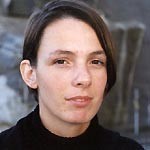 Born in 1967, lives and works in New York and London.
Born in 1967, lives and works in New York and London.
Pia Rönicke’s video Somewhere Out There is like a sightseeing trip through different worlds, built by using a collage technique: cities, landscape sceneries, home environments, public places, and different combinations of them all. The work mixes images conveying the most sophisticated and grand aspects of modernism with cuttings from comics and other visual material located outside of the exclusive premises of art and architecture. The result is an imaginative, seductive journey in and out of contexts where modernism and the cartoons participate on equal, playful terms. This way, a group of buildings resembling something Le Corbusier might have designed, ends up inside the jungle of the cartoon world, while the couple sitting in their well-designed couch in their equally well-designed home take off from the floor, floating away. There’s a clear fascination for the aesthetics and ideology of modernism in Pia Rönicke’s work, but there’s also a critical stance, not least from a feminist perspective.
Superflex
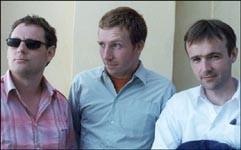 Superflex: Rasmus Nielsen, Jakob Fenger and Bjornstjerne Christiansen, live and work in co-operation in Copenhagen since 1993. Quite in the spirit of Superflex, Bjornstjerne Christiansen – who had been taken ill at the time when the photograph was taken – is represented by an avatar in the form of artist Olaf Nicolai (on the left).
Superflex: Rasmus Nielsen, Jakob Fenger and Bjornstjerne Christiansen, live and work in co-operation in Copenhagen since 1993. Quite in the spirit of Superflex, Bjornstjerne Christiansen – who had been taken ill at the time when the photograph was taken – is represented by an avatar in the form of artist Olaf Nicolai (on the left).
Karlskrona II by the artist group Superflex is a virtual version of Karlskrona’s town centre that you can access via an Internet home page. The work of art uses the Internet on a local level in order to create a more direct and open channel of communication between the local politicians and the citizens of Karlskrona. In that way, Karlskrona 2 is supposed to be a public place where each and every one can put forward suggestions on changes or improvements – big or small – for the town. Anyone wishing to share his or her views through the work or by acting in the virtual environment can choose to be represented by an avatar. Each avatar is free to create new solutions for the virtual town centre, such as building new streets or moving buildings. Every action in the virtual town can also be seen in the actual one, on a large screen in the centre of Karlskrona. The version of the work shown as a part of What If is an elaborate demonstration model of the project.
Pae White
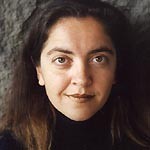 Pae White, born in 1963 in Pasadena, lives and works in Los Angeles.
Pae White, born in 1963 in Pasadena, lives and works in Los Angeles.
Pae White’s work consists of among other things thirty small posters that each and every one is her own graphic expression of the artists that participate in the exhibition What if and their work. It is double printed matter in poster format where one side shows the picture of a piece of work and the other side shows her own artistic interpretation, understanding and commentary on the piece of work. The posters are intended as a very flexible way of using the exhibition – to be arranged and rearranged after personal tastes and preferences on the wall at home. Pae White rejects the form of catalogue normally used for group exhibitions where the printed matter is often separated from the real dynamic and place in time and space of the exhibition. Therefore all graphic material belonging to What if and that is signed Pae White, will also be gathered in a box to be sold to anyone who wishes to make their own extension or alteration of the exhibition – or just keep it as a giftbox.
